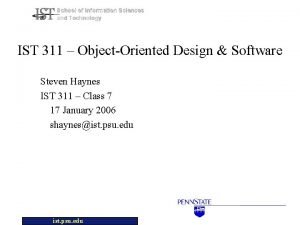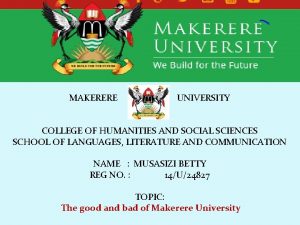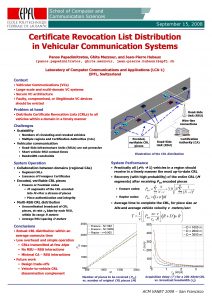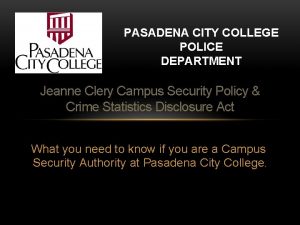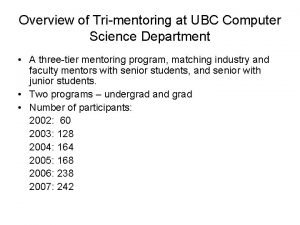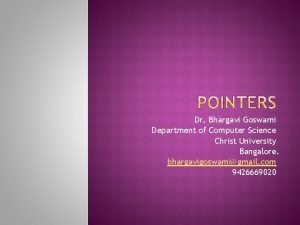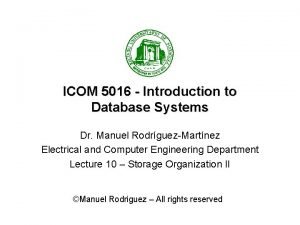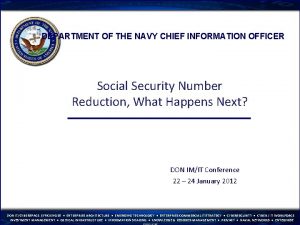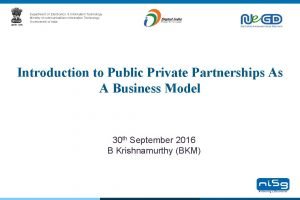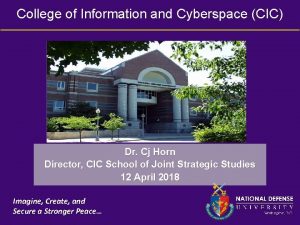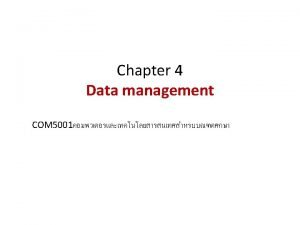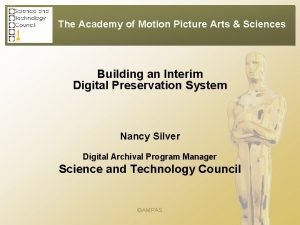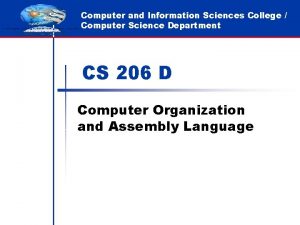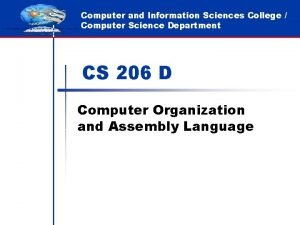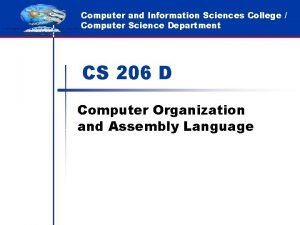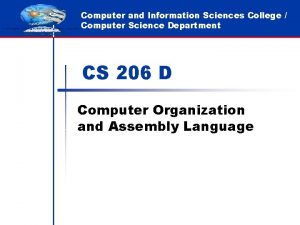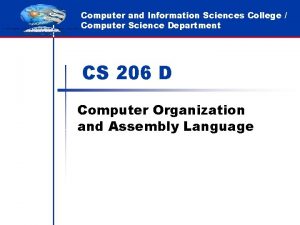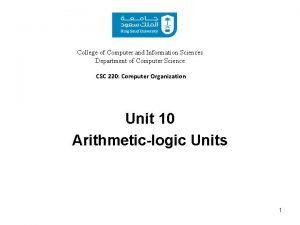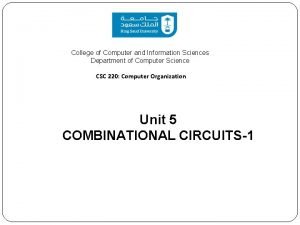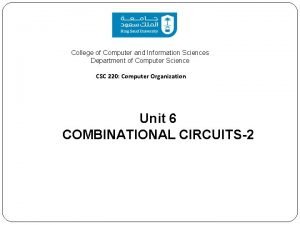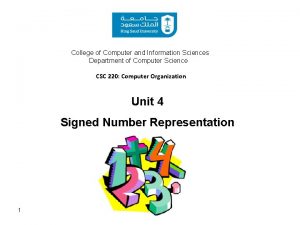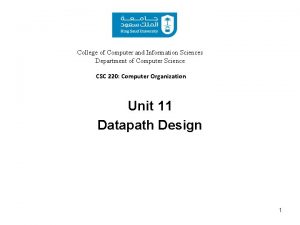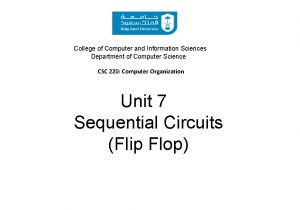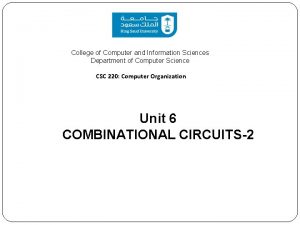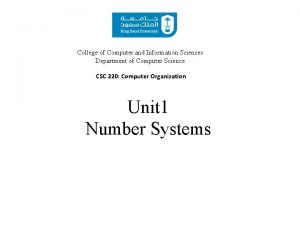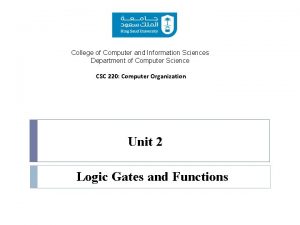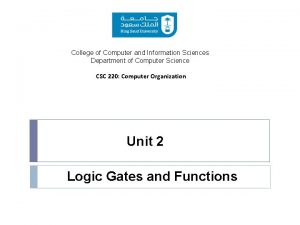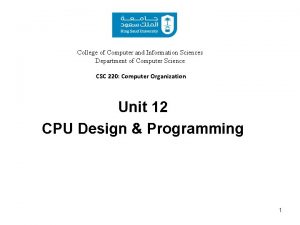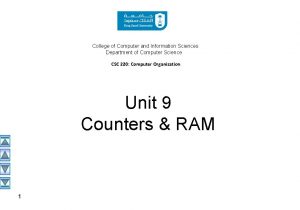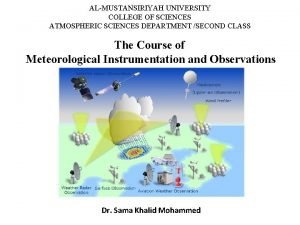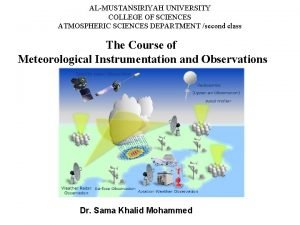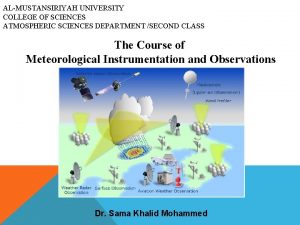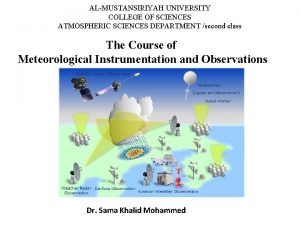College of Computer and Information Sciences Department of




































- Slides: 36

College of Computer and Information Sciences Department of Computer Science CSC 220: Computer Organization Unit 8 Registers and RTL

Unit 8: Registers and RTL Overview • Registers • Parallel in Parallel out Registers • Shift Registers • Bus Construction • Register Transfer Language • Micro operations Chapter-6 M. Morris Mano, Charles R. Kime and Tom Martin, Logic and Computer Design Fundamentals, Global (5 th) Edition, Pearson Education Limited, 2016. ISBN: 9781292096124

3 Dr Mohamed A Berbar

4

5

6

MUX 2 - 1 7

8

9

10

Serial Parallel MUX 2 - 1 11 MUX 2 - 1

A Bidirectional Shift Register with parallel load S 1 S 0 Operation 0 0 No change 0 1 Shift left 1 0 Shift right 1 1 Parallel load 12

Other types of shift registers • • 13 Logical shifts – Standard shifts like we just saw. In the absence of a SI input, 0 occupies the vacant position. – Left: 0110 -> 1100 – Right: 0110 -> 0011 Circular shifts (also called ring counters or rotates) – The shifted out bit wraps around to the vacant position. – Left: 1001 -> 0011 – Right: 1001 -> 1100 Switch-tail ring counter (aka Johnson counter) – Similar to the ring counter, but the serial input is the complement of the serial output. – Left: 1001 -> 0010 – Right: 1001 -> 0100 Arithmetical shifts – Left shifting is the same as a logical shift. Right shifting however maintains the MSB. – Left: 0110 -> 1100 – Right: 0110 -> 0011; 1011 -> 1101

Example • Consider a 4 -bit register with the following inputs S 2 S 1 S 0 0 left shift 0 0 1 circular left shift – left serial input LSI = 1 (This is the serial input for a left shift. ) 0 1 0 right shift – right serial input RSI = 0 (This is the serial input for a right shift. ) 0 1 1 circular right shift 1 0 0 no change 1 0 1 parallel load 1 1 0 complement each bit 1 1 1 set to 1111 – parallel data inputs ABCD = 0011 – The three control inputs S 2, S 1, S 0 operate as shown in the table to the right. – Let the initial register content be QAQBQCQD = 0101 14 Operation

Example S 2 0 S 1 0 S 0 0 QA QB QC QD 0 1 S 2 S 1 S 0 Operation 0 0 0 left shift 0 0 1 circular left shift 0 1 0 right shift 0 1 1 circular right shift 1 0 0 no change 0 0 1 0 1 0 1 parallel load 0 1 1 0 complement each bit 1 0 1 1 set to 1111 1 0 0 0 1 1 0 15 Other Information Parallel Load ABCD = 0011 LS 1 1 RSI 0

Example S 2 0 S 1 0 S 0 0 QA QB QC QD 0 1 S 2 S 1 S 0 Operation 0 0 0 left shift 0 0 1 circular left shift 0 1 0 right shift 0 1 1 circular right shift 1 0 0 no change 0 0 1 0 1 0 1 parallel load 0 1 1 0 complement each bit 1 0 1 1 set to 1111 1 0 0 0 1 1 0 16 Other Information Parallel Load ABCD = 0011 LS 1 1 RSI 0

Example S 2 0 S 1 0 S 0 0 QA QB QC QD 0 1 1 S 2 S 1 S 0 Operation 0 0 0 left shift 0 0 1 circular left shift 0 1 0 right shift 0 1 1 circular right shift 1 0 0 no change 0 0 1 0 1 0 1 parallel load 0 1 1 0 complement each bit 1 0 1 1 set to 1111 1 0 0 0 1 1 0 17 Other Information Parallel Load ABCD = 0011 LS 1 1 RSI 0

Example S 2 0 S 1 0 S 0 0 QA QB QC QD 0 1 1 1 S 2 S 1 S 0 Operation 0 0 0 left shift 0 0 1 circular left shift 0 1 0 right shift 0 1 1 circular right shift 1 0 0 no change 0 0 1 0 1 0 1 parallel load 0 1 1 0 complement each bit 1 0 1 1 set to 1111 1 0 0 0 1 1 0 18 Other Information Parallel Load ABCD = 0011 LS 1 1 RSI 0

Example S 2 0 S 1 0 S 0 0 QA QB QC QD 0 1 1 1 0 0 1 1 S 2 S 1 S 0 Operation 0 0 0 left shift 0 0 1 circular left shift 0 1 0 right shift 0 1 1 circular right shift 1 0 0 no change 0 0 1 0 1 0 1 parallel load 0 1 1 0 complement each bit 1 0 1 1 set to 1111 1 0 0 0 1 1 0 19 Other Information Parallel Load ABCD = 0011 LS 1 1 RSI 0

Example S 2 0 S 1 0 S 0 0 QA QB QC QD 0 1 1 0 0 1 1 1 1 S 2 S 1 S 0 Operation 0 0 0 left shift 0 0 1 circular left shift 0 1 0 right shift 0 1 1 circular right shift 1 0 0 no change 1 0 1 parallel load 0 0 1 0 1 0 0 0 1 1 0 complement each bit 1 0 1 1 set to 1111 1 0 0 0 1 1 0 20 Other Information Parallel Load ABCD = 0011 LS 1 1 RSI 0

Example S 2 0 S 1 0 S 0 0 1 0 1 0 0 0 1 1 1 1 0 0 0 1 1 0 21 QA QB QC QD 0 1 1 0 0 0 1 1 1 1 1 S 2 S 1 S 0 Operation 0 0 0 left shift 0 0 1 circular left shift 0 1 0 right shift 0 1 1 circular right shift 1 0 0 no change 1 0 1 parallel load 1 1 0 complement each bit 1 1 1 set to 1111 Other Information Parallel Load ABCD = 0011 LS 1 1 RSI 0

Example S 2 0 S 1 0 S 0 0 1 0 1 0 0 0 1 1 1 1 0 0 0 1 1 0 22 QA QB QC QD 0 1 1 0 0 0 1 1 0 1 1 1 1 S 2 S 1 S 0 Operation 0 0 0 left shift 0 0 1 circular left shift 0 1 0 right shift 0 1 1 circular right shift 1 0 0 no change 1 0 1 parallel load 1 1 0 complement each bit 1 1 1 set to 1111 Other Information Parallel Load ABCD = 0011 LS 1 1 RSI 0

Example S 2 0 S 1 0 S 0 0 1 0 1 0 0 0 1 1 1 1 0 0 0 1 1 0 23 QA QB QC QD 0 1 1 0 0 0 1 0 1 0 0 1 1 1 1 1 S 2 S 1 S 0 Operation 0 0 0 left shift 0 0 1 circular left shift 0 1 0 right shift 0 1 1 circular right shift 1 0 0 no change 1 0 1 parallel load 1 1 0 complement each bit 1 1 1 set to 1111 Other Information Parallel Load ABCD = 0011 LS 1 1 RSI 0

Example S 2 0 S 1 0 S 0 0 1 0 1 0 0 0 1 1 1 1 0 0 0 1 1 0 24 QA QB QC QD 0 1 1 0 0 0 0 1 1 1 1 1 S 2 S 1 S 0 Operation 0 0 0 left shift 0 0 1 circular left shift 0 1 0 right shift 0 1 1 circular right shift 1 0 0 no change 1 0 1 parallel load 1 1 0 complement each bit 1 1 1 set to 1111 Other Information Parallel Load ABCD = 0011 LS 1 1 RSI 0

Example S 2 0 S 1 0 S 0 0 1 0 1 0 0 0 1 1 1 1 0 0 0 1 1 0 25 QA QB QC QD 0 1 1 0 0 0 0 1 1 1 1 1 0 0 S 2 S 1 S 0 Operation 0 0 0 left shift 0 0 1 circular left shift 0 1 0 right shift 0 1 1 circular right shift 1 0 0 no change 1 0 1 parallel load 1 1 0 complement each bit 1 1 1 set to 1111 Other Information Parallel Load ABCD = 0011 LS 1 1 RSI 0

Bus Construction w A bus consists of a set of parallel data lines w To transfer data using a bus: w connect the output of the source register to the bus; w connect the input of the target register to the bus; w when the clock pulse arrives, the transfer occurs

Bus and Memory transfers 27

Step 1: The content of register C is placed on the bus Step 2: The content of the bus is loaded into register A by activating its load control input. 28

Question A digital computer has a common bus system for 16 registers of 32 bit each. The bus is constructed with multiplexers. – How many selection inputs are there is each multiplexer? – What size of multiplexers is needed? – How many multiplexers are there in the bus? 29

Register Transfer Language • Micro operations (micro-ops) are operations on data stored in registers • Register transfer language (RTL) is a concise and precise means of describing those operations • RTL expressions are made up of elements which describe the registers being manipulated, and the micro-ops being performed on them Registers are denoted by uppercase letters (sometimes followed by numbers) that indicate the function of the register – e. g. R 0, R 1, AR, PC, MAR, et al. – The individual bits can be denoted using parenthesis and bit numbers or labels • e. g. R 0(0), R 0(7: 0), PC(L), PC(H) •

Note: The contents of the source register do not change as a result of the transfer— only the contents of the destination register change. 31

• • 32 A statement that specifies a register transfer implies that datapath circuits are available from the outputs of the source register to the inputs of the destination register and that the destination register has a parallel load capability. Every statement written in register-transfer notation presupposes a hardware construct for implementing the transfer. All RTL statements occur in response to a clock tick. Normally we want a given transfer to occur not for every clock pulse, but only for specific values of the control signals. – RTL conditional statements: • e. g. If (K 1 = 1) Then (R 2 R 1) – Control function notation (Colon, : ) • e. g. K 1: R 2 R 1 A comma is used to separate two or more register transfers that are executed at the same time. – e. g. Go: R 2 R 1, R 4 R 3

33

Bitwise operations • • Most computers also support logical operations like AND, OR and NOT, but extended to multi-bit words instead of just single bits. To apply a logical operation to two words X and Y, apply the operation on each pair of bits Xi and Yi: 1 AND 1 1 • 0 1 1 OR 1 0 1 11 1 XOR 01 1 10 Single operand logical operation: “complementing” all the bits in a number. NOT 1 0 34 11 01 01 0 1 0 0 1 1 0

35

36
 College of information sciences and technology
College of information sciences and technology Human sciences
Human sciences College of humanities and social sciences
College of humanities and social sciences Clas advising uf
Clas advising uf Usf college of behavioral and community sciences
Usf college of behavioral and community sciences School of computer and communication sciences
School of computer and communication sciences Queens high school for the sciences
Queens high school for the sciences Aggie advising college of biological sciences
Aggie advising college of biological sciences Site:slidetodoc.com
Site:slidetodoc.com Tum
Tum Latest electronic and information technology in odisha
Latest electronic and information technology in odisha Pasadena city college police department
Pasadena city college police department Computer science ucl
Computer science ucl Northwestern computer science department
Northwestern computer science department Computer science department rutgers
Computer science department rutgers Meredith hutchin
Meredith hutchin Fsu computer science department
Fsu computer science department Trimentoring
Trimentoring Department of computer science christ
Department of computer science christ Computer engineering department
Computer engineering department Mice.cs.columbia
Mice.cs.columbia Ucf software engineering
Ucf software engineering Department of information technology
Department of information technology Department of information engineering university of padova
Department of information engineering university of padova Information engineering padova
Information engineering padova Navy chief information officer
Navy chief information officer Department of electronics & information technology
Department of electronics & information technology College of information and cyberspace
College of information and cyberspace Wake tech admissions
Wake tech admissions Early college high school at midland college
Early college high school at midland college General objectives of computer
General objectives of computer Difference between a computer and computer system
Difference between a computer and computer system Output devices drawing
Output devices drawing Difference between architecture and organisation
Difference between architecture and organisation Difference between data and information in computer
Difference between data and information in computer It holds data, instructions, and information for future use
It holds data, instructions, and information for future use Academy of motion picture arts and sciences benefits
Academy of motion picture arts and sciences benefits
